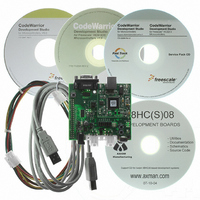DEMO9S08EL32 Freescale Semiconductor, DEMO9S08EL32 Datasheet - Page 261

DEMO9S08EL32
Manufacturer Part Number
DEMO9S08EL32
Description
BOARD DEMO FOR 9S08 EL MCU
Manufacturer
Freescale Semiconductor
Type
MCUr
Datasheets
1.DEMO9S08EL32.pdf
(356 pages)
2.DEMO9S08EL32.pdf
(14 pages)
3.DEMO9S08EL32.pdf
(2 pages)
Specifications of DEMO9S08EL32
Contents
Evaluation Board
Processor To Be Evaluated
MC9S08EL32
Data Bus Width
8 bit
Interface Type
RS-232, USB
Operating Supply Voltage
12 V
Silicon Manufacturer
Freescale
Core Architecture
HCS08
Core Sub-architecture
HCS08
Silicon Core Number
MC9S08
Silicon Family Name
S08EL
Rohs Compliant
Yes
For Use With/related Products
MC9S08EL32
Lead Free Status / RoHS Status
Lead free / RoHS Compliant
- Current page: 261 of 356
- Download datasheet (9Mb)
Writing 0 to TE does not immediately release the pin to be a general-purpose I/O pin. Any transmit activity
that is in progress must first be completed. This includes data characters in progress, queued idle
characters, and queued break characters.
14.3.2.1
The SBK control bit in SCIxC2 is used to send break characters which were originally used to gain the
attention of old teletype receivers. Break characters are a full character time of logic 0 (10 bit times
including the start and stop bits). A longer break of 13 bit times can be enabled by setting BRK13 = 1.
Normally, a program would wait for TDRE to become set to indicate the last character of a message has
moved to the transmit shifter, then write 1 and then write 0 to the SBK bit. This action queues a break
character to be sent as soon as the shifter is available. If SBK is still 1 when the queued break moves into
the shifter (synchronized to the baud rate clock), an additional break character is queued. If the receiving
device is another Freescale Semiconductor SCI, the break characters will be received as 0s in all eight data
bits and a framing error (FE = 1) occurs.
When idle-line wakeup is used, a full character time of idle (logic 1) is needed between messages to wake
up any sleeping receivers. Normally, a program would wait for TDRE to become set to indicate the last
character of a message has moved to the transmit shifter, then write 0 and then write 1 to the TE bit. This
action queues an idle character to be sent as soon as the shifter is available. As long as the character in the
shifter does not finish while TE = 0, the SCI transmitter never actually releases control of the TxD pin. If
there is a possibility of the shifter finishing while TE = 0, set the general-purpose I/O controls so the pin
that is shared with TxD is an output driving a logic 1. This ensures that the TxD line will look like a normal
idle line even if the SCI loses control of the port pin between writing 0 and then 1 to TE.
The length of the break character is affected by the BRK13 and M bits as shown below.
14.3.3
In this section, the receiver block diagram
functional description. Next, the data sampling technique used to reconstruct receiver data is described in
more detail. Finally, two variations of the receiver wakeup function are explained.
The receiver input is inverted by setting RXINV = 1. The receiver is enabled by setting the RE bit in
SCIxC2. Character frames consist of a start bit of logic 0, eight (or nine) data bits (LSB first), and a stop
bit of logic 1. For information about 9-bit data mode, refer to
For the remainder of this discussion, we assume the SCI is configured for normal 8-bit data mode.
After receiving the stop bit into the receive shifter, and provided the receive data register is not already
full, the data character is transferred to the receive data register and the receive data register full (RDRF)
Freescale Semiconductor
Receiver Functional Description
Send Break and Queued Idle
MC9S08EL32 Series and MC9S08SL16 Series Data Sheet, Rev. 3
BRK13
0
0
1
1
Table 14-8. Break Character Length
M
0
1
0
1
(Figure
14-3) is used as a guide for the overall receiver
Break Character Length
10 bit times
11 bit times
13 bit times
14 bit times
Section 14.3.5.1, “8- and 9-Bit Data
Serial Communications Interface (S08SCIV4)
Modes.”
263
Related parts for DEMO9S08EL32
Image
Part Number
Description
Manufacturer
Datasheet
Request
R
Part Number:
Description:
Manufacturer:
Freescale Semiconductor, Inc
Datasheet:
Part Number:
Description:
Manufacturer:
Freescale Semiconductor, Inc
Datasheet:
Part Number:
Description:
Manufacturer:
Freescale Semiconductor, Inc
Datasheet:
Part Number:
Description:
Manufacturer:
Freescale Semiconductor, Inc
Datasheet:
Part Number:
Description:
Manufacturer:
Freescale Semiconductor, Inc
Datasheet:
Part Number:
Description:
Manufacturer:
Freescale Semiconductor, Inc
Datasheet:
Part Number:
Description:
Manufacturer:
Freescale Semiconductor, Inc
Datasheet:
Part Number:
Description:
Manufacturer:
Freescale Semiconductor, Inc
Datasheet:
Part Number:
Description:
Manufacturer:
Freescale Semiconductor, Inc
Datasheet:
Part Number:
Description:
Manufacturer:
Freescale Semiconductor, Inc
Datasheet:
Part Number:
Description:
Manufacturer:
Freescale Semiconductor, Inc
Datasheet:
Part Number:
Description:
Manufacturer:
Freescale Semiconductor, Inc
Datasheet:
Part Number:
Description:
Manufacturer:
Freescale Semiconductor, Inc
Datasheet:
Part Number:
Description:
Manufacturer:
Freescale Semiconductor, Inc
Datasheet:
Part Number:
Description:
Manufacturer:
Freescale Semiconductor, Inc
Datasheet:










